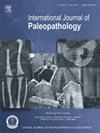External auditory exostoses in fragmentary remains: Evidence for activity and human-environment interactions at Early Neolithic Bestansur, Iraqi Kurdistan
IF 1.5
3区 地球科学
Q3 PALEONTOLOGY
引用次数: 0
Abstract
Objectives
This research assesses external auditory exostoses (EAEs) as markers of aquatic activity in individuals from the Early Neolithic inland site of Bestansur, Iraqi Kurdistan (c.7700–7100 BCE).
Materials
Thirty-four individuals (6 non-adults and 28 adults) represented by 50 external auditory canals (27 left and 23 right), both fragmentary and intact, were included in the study.
Methods
Auditory canals were macroscopically examined for the presence or absence of bone growths, with their location and severity recorded.
Results
Twenty-four individuals (70.6 %) and 31 auditory canals (62 %), 18 left (66.7 %) and 13 right (56.5 %), displayed EAEs. No significant differences in -frequency were found according to biological sex, age-at-death or burial location.
Conclusions
Supported by archaeological evidence, the frequency of EAEs at Bestansur suggests male, female and non-adult engagement in fishing, mollusc harvesting and, possibly, other activities in aquatic environments, shedding light on social participation and the importance of freshwater habitats in Neolithic economies in the Zagros.
Significance
While adding to previous studies of EAEs in fragmentary remains, this research highlights the benefit of contextualised palaeopathological analysis as a means of exploring human behaviour and human-environment interactions. The assessment of EAEs in past populations can offer insights into the variables shaping human behaviour and complex subsistence strategies.
Limitations
Sample size and distribution were affected by poor preservation, requiring interpretative caution.
Suggestions for further research
Future research should acquire regional comparative data and explore correlations between EAE location and severity, and co-occurrences of bone changes in the auditory canal.
残片遗骸中的外耳外露:伊拉克库尔德斯坦贝斯坦苏尔新石器时代早期人类活动和环境相互作用的证据。
目的:本研究评估了来自伊拉克库尔德斯坦贝斯坦苏尔新石器时代早期内陆遗址(公元前7700-7100年)个体的外耳外植骨(eae)作为水生活动的标志。材料:34人(非成人6人,成人28人),50条外耳道(左27条,右23条),均为残缺和完整。方法:宏观检查听道是否有骨生长,记录其位置和严重程度。结果:24例(70.6 %),31例(62 %),左侧18例(66.7 %),右侧13例(56.5 %)出现eae。根据生理性别、死亡年龄或埋葬地点,在频率上没有发现显著差异。结论:在考古证据的支持下,Bestansur地区eae的频率表明,男性、女性和非成人参与了捕鱼、软体动物捕捞以及可能的其他水生环境活动,这揭示了扎格罗斯地区新石器时代经济中社会参与和淡水栖息地的重要性。意义:虽然增加了先前对碎片遗骸中eae的研究,但本研究强调了背景化古病理学分析作为探索人类行为和人与环境相互作用的手段的好处。对过去种群中eae的评估可以深入了解影响人类行为和复杂生存策略的变量。局限性:样本量和分布受到保存不良的影响,需要谨慎解释。进一步研究建议:未来的研究应获取区域比较数据,探索EAE位置与严重程度的相关性,以及听道骨改变的共现性。
本文章由计算机程序翻译,如有差异,请以英文原文为准。
求助全文
约1分钟内获得全文
求助全文
来源期刊

International Journal of Paleopathology
PALEONTOLOGY-PATHOLOGY
CiteScore
2.90
自引率
25.00%
发文量
43
期刊介绍:
Paleopathology is the study and application of methods and techniques for investigating diseases and related conditions from skeletal and soft tissue remains. The International Journal of Paleopathology (IJPP) will publish original and significant articles on human and animal (including hominids) disease, based upon the study of physical remains, including osseous, dental, and preserved soft tissues at a range of methodological levels, from direct observation to molecular, chemical, histological and radiographic analysis. Discussion of ways in which these methods can be applied to the reconstruction of health, disease and life histories in the past is central to the discipline, so the journal would also encourage papers covering interpretive and theoretical issues, and those that place the study of disease at the centre of a bioarchaeological or biocultural approach. Papers dealing with historical evidence relating to disease in the past (rather than history of medicine) will also be published. The journal will also accept significant studies that applied previously developed techniques to new materials, setting the research in the context of current debates on past human and animal health.
 求助内容:
求助内容: 应助结果提醒方式:
应助结果提醒方式:


